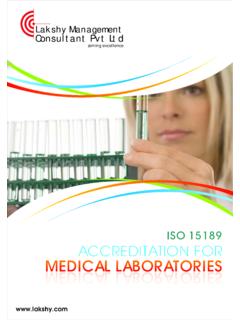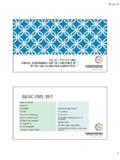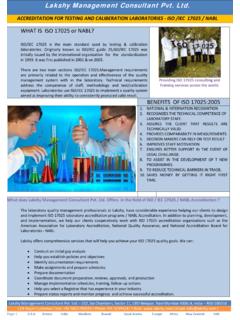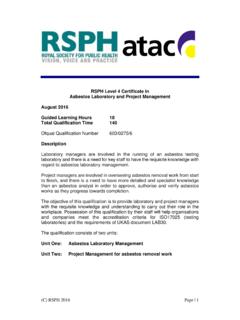Transcription of Strategic Considerations for ffoorr for Successful ...
1 Strategic Considerations Strategic Considerations Strategic Considerations Strategic Considerations for for for for Successful Analytical Method TransferSuccessful Analytical Method TransferSuccessful Analytical Method TransferSuccessful Analytical Method TransferAnalytical Method Development, Validation and TransferAnalytical Method Development, Validation and TransferAnalytical Method Development, Validation and TransferAnalytical Method Development, Validation and TransferAnalytical Method Development, Validation and TransferAnalytical Method Development, Validation and TransferAnalytical Method Development, Validation and TransferAnalytical Method Development, Validation and TransferConference, September 14 & 15, PragueConference, September 14 & 15, PragueConference, September 14 & 15, PragueConference, September 14 & 15, PragueBernhard Noll, PhD Bernhard Noll, PhD Bernhard Noll, PhD Bernhard Noll, PhD Roche Kulmbach GmbHRoche Kulmbach GmbHRoche Kulmbach GmbHRoche Kulmbach GmbHOverviewOverviewOverviewOverview Definition of Method Transfer Method Transfer and Validation - When to Re-Validate?
2 Practical Considerations for Pre & Post Analytical Method Transfer Planning for a Method Transfer Contractual communication2 Contractual communication Technical communication Responsibilities Contemplating failure: Case studies Preparing protocols for Successful method transfer Considerations for adopting a global company documentWhat is method transfer?What is method transfer?What is method transfer?What is method transfer?Method transfer is the process of transferring a validated analytical method from a sendinglaboratory to a receiving laboratory, after demonstrating experimentally that it also mastersthe method. From: Rozet et al., JChrB, 877 (2009) 2214-2223 (Review) 3 Protocol driven study with pre-determined acceptance criteria Demonstration of a laboratory s proficiency in running a particular method Verification of a method s suitability for it s intended useFrom: Saffell-Clemmer & Nail, BioPharma Solutions, Webinar presentation 2007 What is method transfer?
3 What is method transfer?What is method transfer?What is method transfer? Method transfers are closely related to validation More challenging because multiple laboratories and companies are involved 4 Different approaches to Validation and Transfer Different expectations of what is an acceptable Validation Different instruments and facilitiesHas emphasis on Method Transfer increased?Has emphasis on Method Transfer increased?Has emphasis on Method Transfer increased?Has emphasis on Method Transfer increased? Increase in outsourcing and subcontracting (contract manufacturing, use of CROs)in the pharmaceutical industry Increase in importance of biologic / biopharmaceutical products Biologic / biopharmaceutical products require:5 Biologic / biopharmaceutical products require: More complex methods Multiple orthogonal methods Appropriate procedures to control development Expected to be in accordance with: Good business practice Regulatory guidanceRegulatory GuidanceRegulatory GuidanceRegulatory GuidanceRegulatory Guidance No Detailed Official Guidance Exists for Method Transfer.
4 Instead No Detailed Official Guidance Exists for Method Transfer. Instead No Detailed Official Guidance Exists for Method Transfer. Instead No Detailed Official Guidance Exists for Method Transfer. Instead Rely on ICH and FDA Guidance on Method ValidationRely on ICH and FDA Guidance on Method ValidationRely on ICH and FDA Guidance on Method ValidationRely on ICH and FDA Guidance on Method Validation 21 CFR Part US FDA. Guidance for Industry, ICH Q2(R1)6 US FDA. Guidance for Industry, ICH Q2(R1) US FDA. Guidance for Industry: Bioanalytical Method Validation, 2001 US FDA. Guidance for Industry: Analytical procedures and Method Validation EMA. Concept paper/ reccommendations on need for a (CHMP) guidline on the validation of bioanalytical methods. 2009 Types of Method TransferTypes of Method TransferTypes of Method TransferTypes of Method Transfer Comparative testingComparative testingComparative testingComparative testing Involves two or more laboratories Preapproved protocol Predetermined acceptance criteria Covalidation between two laboratoriesCovalidation between two laboratoriesCovalidation between two laboratoriesCovalidation between two laboratories Receiving laboratory is involved in Validation ( : interlaboratory qualification)7 Receiving laboratory is involved in Validation (.)
5 Interlaboratory qualification) Validation report as proof of transfer Method validation/reMethod validation/reMethod validation/reMethod validation/re----validationvalidationval idationvalidation Receiving laboratory repeats some or all validation experiments Transfer waiferTransfer waiferTransfer waiferTransfer waifer No comparative data required Receiving laboratory is using same or similar method Or Method is common and well established (pH, Density) Formal documentation justifying the waiving of experimental evidence is requiredReReReRe----validate or not?validate or not?validate or not?validate or not? whenever a method is changed, and the new parameter lies outside the operating range Column Temp 41 C , Operation Range 30-40 C if the scope of the method has been changed or extendedA ReA ReA ReA Re----Validation is Necessary,Validation is Necessary,Validation is Necessary,Validation is Necessary,8 if the scope of the method has been changed or extended Change of sample matrix / operating conditions if instruments with new characteristics are used, not covered by the initial validation New HPLC pump delay of mL vs.
6 A validated delay of 5 mL if system suitability tests, or results of sample analysis, lie outside preset acceptance criteria and where the source of the error cannot be traced From: Validation of Analytical Methods and Procedures, Author: Dr. Ludwig HuberPractical Considerations for PrePractical Considerations for PrePractical Considerations for PrePractical Considerations for Pre----Method TransferMethod TransferMethod TransferMethod Transfer An open and responsive communication between sending and receiving site is essential for any method transfer 9 Practical Considerations for PrePractical Considerations for PrePractical Considerations for PrePractical Considerations for Pre----Method TransferMethod TransferMethod TransferMethod Transfer Single contact person for all methods into receiving company/site Single contact person for all methods from sending company/site Scientific teams to communicate early and frequentlyCommunication / Responsibilities:Communication / Responsibilities:Communication / Responsibilities:Communication / Responsibilities.
7 10 Scientific teams to communicate early and frequently Thorough evaluation of the method at the sending site prior to drafting the transfer protocol Determine early, if any clarification to the method procedure is needed Evalute site specific issues Instrumentation Reagents Data collection systemsPractical Considerations for PrePractical Considerations for PrePractical Considerations for PrePractical Considerations for Pre----Method TransferMethod TransferMethod TransferMethod Transfer Method Transfer involves multiple pathways of communication Method Transfer involves multiple pathways of communication Method Transfer involves multiple pathways of communication Method Transfer involves multiple pathways of communication Client Site A Client Site A Client Site A Client Site A Client Site B Client Site B Client Site B Client Site B Analytical methodsReference materialsImpurity markers (API)API ManufactureSynthesis DevelopmentAnalytical DevelopmentAPI GLP ReleaseDP GLP Release API/DP StabilityClient11 CMO A (API) CMO A (API) CMO A (API)
8 CMO A (API) Study sitesStudy sitesStudy sitesStudy sitesActive Substance (API)Reference materialsAPI ManufactureAPI ReleaseAPI StabilityDP ManufactureDP ReleaseDP StabilityCMO B (DP) CMO B (DP) CMO B (DP) CMO B (DP) Finished Product Vials (DP)In vivostudiesCMOP ractical Considerations for PrePractical Considerations for PrePractical Considerations for PrePractical Considerations for Pre----Method TransferMethod TransferMethod TransferMethod Transfer PrePrePrePre----approved Transfer Protocol:approved Transfer Protocol:approved Transfer Protocol:approved Transfer Protocol: Describes the General Transfer Process Clearly Defines Responsibilities (at sending and receiving site) Provides Specific Acceptance Criteria Lists MethodsInformationInformationInformation Information to Provide from the SendingSendingSendingSending Laboratory:12 Lists Methods Provides Categorization of Method API, Raw material, In-process, stability or final product ID, Potency, purity/related substances or residue analysis Describes Materials and Samples Light-sensitive, adheres to plastics Provides Batch/Lot Numbers Includes Certificates of Analysis Describes Instrumentation and ParametersPractical Considerations for PrePractical Considerations for PrePractical Considerations for PrePractical Considerations for Pre----Method TransferMethod TransferMethod TransferMethod TransferMaterialsMaterialsMaterialsMater ials to Provide from the SendingSendingSendingSending Laboratory.
9 Method System Suitability Parameters Rationale for Chosen Parameters Step-by-Step Directions Tips and Tricks13 Tips and Tricks Safety Considerations Validation Report Reference Standards Samples for Evaluation Difficult to Purchase SuppliesContemplating Failure: Contemplating Failure: Contemplating Failure: Contemplating Failure: 14 Contemplating Failure : Contemplating Failure : Contemplating Failure : Contemplating Failure : Case study: UVCase study: UVCase study: UVCase study: UV----SpectroscopySpectroscopySpectrosco pySpectroscopyAnnealingMeltingACACGUCAGU UG+ACACGUCAGUUG RNA-Duplex is stabilized by buffer salts. Duplex has lower absorbance than monomers. Sample measurements using water vs. dilutionusing buffered Strands(low salt & low conc.)Duplex(high salt & high conc.)ExtinctionExtinctionExtinctionExti nctionCoefficientCoefficientCoefficientC oefficientdetermined in Water (CRO) ExtinctionExtinctionExtinctionExtinction CoefficientCoefficientCoefficientCoeffic ientdetermined in Water (Client) ExtinctionExtinctionExtinctionExtinction CoefficientCoefficientCoefficientCoeffic ientdetermined in 1 x PBS (Client) siRNA-Luc389,000365,000294,900132 %124 %100 %Contemplating Failure: Contemplating Failure: Contemplating Failure: Contemplating Failure: Case study: IonCase study: IonCase study: IonCase study: Ion----Pair ReversedPair ReversedPair ReversedPair Reversed----Phase ChromatographyPhase ChromatographyPhase ChromatographyPhase ChromatographyRNA-Duplex is stabilized by buffer salts.
10 Sample dilution using water vs. dilution using saline caused dissociation of the Duplex. siRNA-LucsiRNA-LucRNA-Duplex16 Effect of sample preparation on non-denaturing IP-RP. Sample in saline (trace 1) and sample in water (trace 2). GS-LucPS-LucsiRNA-Luc12GS-LucPS-LucsiRNA -Luc12 Monomer AMonomer BRNA-DuplexContemplating Failure: Contemplating Failure: Contemplating Failure: Contemplating Failure: Case study: Size exclusion chromatographyCase study: Size exclusion chromatographyCase study: Size exclusion chromatographyCase study: Size exclusion chromatography56 Flow: 300 L/minFlow: 200 L/min5656 Flow: 300 L/minFlow: 200 L/minDue to column pressure limits of the instrument at the receivinglaboratory,HPLC flow rate was decreased, but chromatography time was held constant171234 Flow: 750 L/minFlow: 600 L/minFlow: 500 L/minFlow: 400 L/min12341234 Flow: 750 L/minFlow: 600 L/minFlow: 500 L/minFlow: 400 L/minEffect of different flow rates on SEC separation.






